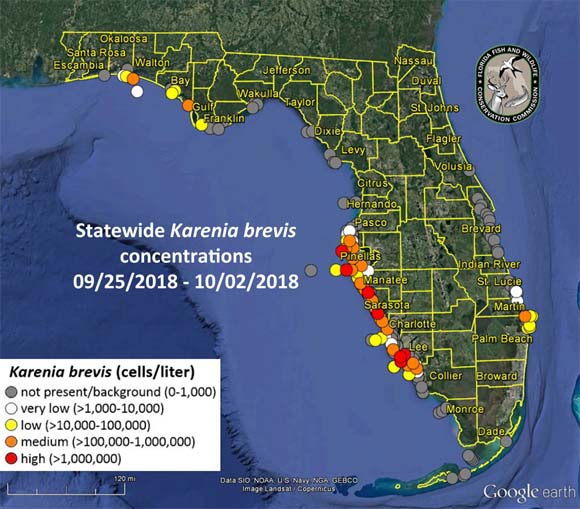Juno Beach. Image: Milan Boers
Officials are warning people with severe respiratory conditions to stay away from some Miami beaches that tested positive for “moderate” levels of red tide algae. Contact with the toxic blooms commonly results in coughing or throat itch, as well as skin irritation and rashes. Eating seafood that has been exposed to red tide can cause serious respiratory issues, and can be fatal.For months, the Gulf Coast has been suffering a devastating bloom of red tide algae, with particularly severe impacts on Florida’s western waterways. Now, Florida’s east coast communities report that the algae has made its way around the peninsula and into Atlantic waters—a rare occurrence that further underscores the urgency of addressing these planktonic outbreaks.Red tide blooms are caused by the rapid proliferation of the microorganism Karenia brevis, which produce toxins and depletes marine ecosystems of oxygen. This process wipes out wildlife, creates health hazards for humans, and disrupts industries like tourism and fisheries.The Gulf Coast bloom began last November, but it became so intense over the summer that Florida Governor Rick Scott declared a temporary state of emergency on August 15, for the state’s most impacted west coast communities. Over the past few months, an estimated 2,000 tons of dead wildlife—killed by the red tide and other algae blooms—has washed up on Florida’s western shorelines, and the cleanup and management effort from both saltwater and freshwater blooms has cost at least $16 million of dollars so far.With the beach closures this week on the east coast, that run of good luck may be over.Due to the huge toll that these blooms have taken on Florida’s economy and environment, they have become a major political issue for Floridians.Governor Scott has consistently referred to these blooms as completely natural. While it is true that red tide is native to Gulf Coast waters and has been observed for centuries, human activity—especially agricultural and industrial pollution—may exacerbate existing blooms, which could explain why red tide has become a more persistent problem in Florida over the past half-century.Get six of our favorite Motherboard stories every day by signing up for our newsletter.
Over the past few months, an estimated 2,000 tons of dead wildlife—killed by the red tide and other algae blooms—has washed up on Florida’s western shorelines, and the cleanup and management effort from both saltwater and freshwater blooms has cost at least $16 million of dollars so far.With the beach closures this week on the east coast, that run of good luck may be over.Due to the huge toll that these blooms have taken on Florida’s economy and environment, they have become a major political issue for Floridians.Governor Scott has consistently referred to these blooms as completely natural. While it is true that red tide is native to Gulf Coast waters and has been observed for centuries, human activity—especially agricultural and industrial pollution—may exacerbate existing blooms, which could explain why red tide has become a more persistent problem in Florida over the past half-century.Get six of our favorite Motherboard stories every day by signing up for our newsletter.
Advertisement

Until recently, the algal menace was confined to the west coast of Florida. But this week, Palm Beach County and Miami-Dade County closed select beaches after red tide algae in the water was detected. Dead fish washed up at Juno Beach, and Governor Scott invested an additional $3 million to affected east coast communities.These county-run beaches were reopened on Friday, but officials warned people with respiratory issues, like asthma, to avoid visiting them.The east coast of the state previously welcomed some of the business and tourism that has been hemorrhaging from the west coast due to the red algae. “We are benefiting from their misfortune,” Glenn Jergensen, executive director of the Palm Beach County Tourist Development Council, told the South Florida Sun-Sentinel in September. “The hoteliers are telling me their numbers are strong. Some of that has to do with folks on the west coast coming over here.”Read More: Floridians Wonder How President-Elect Trump Will Deal With Their Rising Seas
Advertisement
